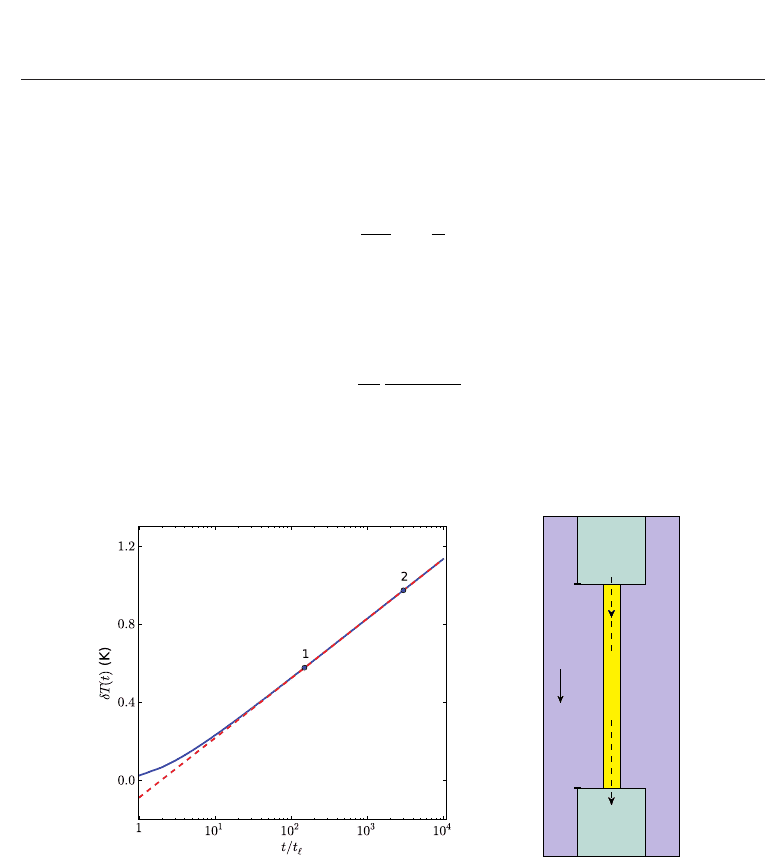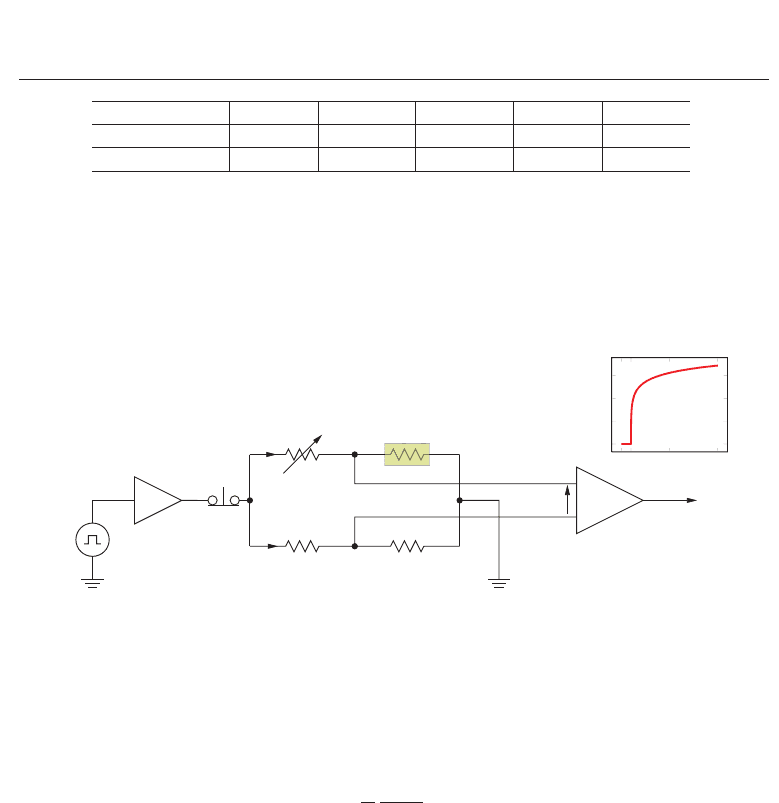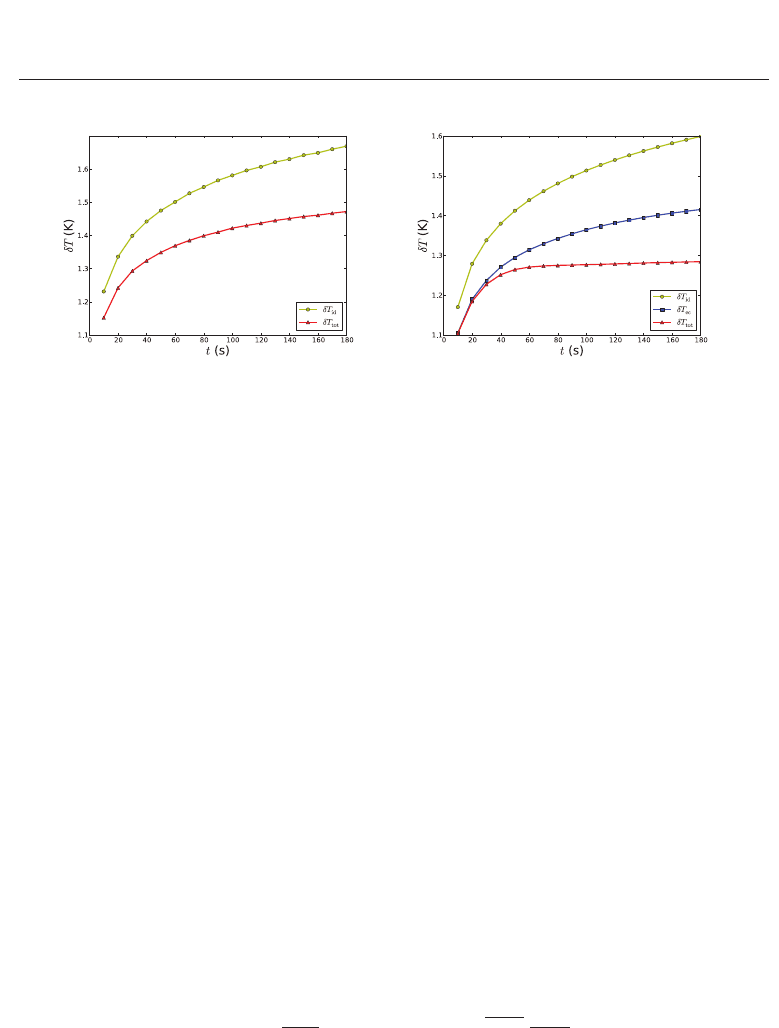Ahsan A. Two Phase Flow, Phase Change and Numerical Modeling
Подождите немного. Документ загружается.


Nanofluids for Heat Transfer 11
from the preceding experimental results:
• For the same volume concentrations, the improvement of thermal conductivity Δk/k
hf
obtained with NPs suspensions is much higher than that obtained with equivalent
suspensions of micro-particles. The classical laws such as Maxwell-Garnett or
Hamilton-Crosser (Tab. 3) are no longer valid in the case of nanofluids (Fig. 4(a)).
• The size d of the nanoparticles has a moderate influence on the improvement of the thermal
conductivity. The more the NPs are smaller, the more the increase is significant (Fig. 4(a),
Tab. 2). This behavior is not predictable using the classical laws of table 3.
• The viscosity of the host fluid also appears to play a significant role that has not been
sufficiently explored so far. As shown by the measurements taken at room temperature
with Al
2
O
3
in various liquids (water, EG and oil) and the measurements of figure 4(b)
about CuO, the improvement of the thermal conductivity increases with the viscosity of
the host fluid.
• The nature of the particles and host fluid also plays an important role. However it is very
difficult to identify clear trends due to the various NPs surface treatments (surfactants,
polymer coating, pH) used to stabilize the suspensions according to the different kinds of
interactions NP/fluid and their chemical affinity. Thus we can assume that the surfactants
and polymer coatings can significantly modify the heat transfer between the nanoparticles
and the fluid.
3.3 Theoretical approaches
3.3.1 Classical macroscopic approach
As mentioned previously, the conventional models (Tab. 3) do not allow to describe the
significant increase of the thermal conductivity observed with nanofluids, even at low
volume fractions. These models are essentially based on solving the stationary heat equation
∇(k∇T)=0 in a macroscopic way. By using metallic particles or oxides, one may assume that
α
= k
p
/k
hf
1 (large thermal contrast). Under these conditions, one can write from the (MG)
mixing rule: φ
MG
≈ 1/(1 + 3k
hf
/Δk). In the case of copper nanoparticles suspended in pump
oil at RT (Table 2), it was found that Δk/k
hf
= 0.45 for φ
exp
= 0.06% while the corresponding
value provided by (MG) is φ
MG
≈ 13%, ie 200 times bigger. These results clearly show that
the macroscopic approach is generally not suitable to explain the improvement of thermal
conductivity of the thermal nanofluids.
3.3.2 Heat transfer mechanisms at nanoscale/new models
We now present the most interesting potential mechanisms allowing to explain the thermal
behavior of nanofluids, which are: Brownian motion, ordered liquid layer at the interface
between the fluid and the NP, agglomeration across the host fluid.
3.3.2.1 Influence of Brownian motion
The Brownian motion (BM) of the NPs, due to the collisions with host fluid molecules, is
frequently mentioned as a possible mechanism for improving the thermal conductivity of
nanofluids. There are at least two levels of interpretation:
1. BM induces collisions between particles, in favor of a thermal transfer of solid/solid type,
better than that of the liquid/solid type (Keblinski et al., 2002). To discuss the validity
of this assumption, we consider the time τ
D
needed by a NP to travel a distance L into
399
Nanofluids for Heat Transfer

12 Will-be-set-by-IN-TECH
Model Law Comments
Φ
Q
k
p
, φ
k
hf
,1− φ
1
k
=
φ
k
p
+
1−φ
k
hf
Series model. No assumption on particles
size and shape. The assembly of particles
is considered as a continuous whole.
Φ
p
Q
Φ
hf
Q
k
p
, φ
k
hf
,1− φ
k = φk
p
+(1 − φ)k
hf
Parralel model. Same comments as
before.
Φ
Q
k
k
hf
= 1 +
3(α−1)φ
α+2−(α−1)φ
Maxwell-Garnett mixing rule (MG) with
α
= k
p
/k
hf
. Spherical, micron
size noninteracting particles randomly
dispersed in a continuous host matrix.
Low volume fractions.
φ
k
p
−k
k
p
+2k
+
(
1 −φ
)
k
hf
−k
k
hf
+2k
= 0 Bruggeman implicit model for a binary
mixture of homogeneous spherical
particles. No limitations on the
concentration of inclusions. Randomly
distributed particles
k
k
hf
=
α+(n−1)+(n−1)(α−1)φ
α+(n−1)−(α−1)φ
Hamilton-Crosser model. Same
hypotheses as Maxwell-Garnett, n
is a form factor introduced to take into
account non-spherical particles (n
= 6
for cylindrical particles).
Table 3. Classical models used to describe the thermal conductivity k of micro-suspensions.
k
p
and k
hf
are respectively the thermal conductivities of the particles and of the host fluid, φ
is the volume fraction of particles and Φ
Q
is the heat flux.
the fluid due to the Brownian motion. According to the equation of diffusion ∂n/∂t
−
∇(
D∇n)=0, this time is of order of τ
D
= L
2
/D,whereD = k
B
T/6πηa
p
is the diffusion
coefficient for a spherical particle of radius a
p
. Considering now the heat transfer time
τ
L
associated to heat diffusion in the liquid, we obtain from the heat transfer equation
ρ
f
c
m
∂T/∂t −∇(k
hf
∇T)=0 in a liquid at rest: τ
L
= L
2
/α = ρ
f
c
m
L
2
/k
hf
. The ratio of
τ
D
/τ
L
is given by:
τ
D
τ
L
=
3πk
hf
ηa
p
ρ
f
c
m
k
B
T
(13)
For water at room temperature (η
= 10
−3
Pa.s, ρ
f
= 10
3
kg/m
3
, k
hf
= 0.58 W/m.K,
c
m
= 4.18 kJ/kg, k
B
= 1.38 10
−23
J/K) and with a
p
= 5 nm, Eq. (13) gives τ
D
/τ
L
≈ 3000.
This result shows that the transport of heat by thermal diffusion in the liquid is much faster
than Brownian diffusion, even within the limit of very small particles. Thus the collisions
induced by BM cannot be considered as the main responsible for the significant increase in
thermal conductivity of the nanofluids.
2. BM induces a flow of fluid around the nanoparticles, in favor of an additional heat transfer
by Brownian forced micro-convection (Wang et al., 2002). To compare the efficiency of the
forced convective heat transfer to the heat transfer by conduction, we express the Nusselt
number Nu for a sphere as (White, 1991):
Nu
= 2 + 0.3Re
0.6
Pr
1/3
= 2 + ΔNu (14)
400
Two Phase Flow, Phase Change and Numerical Modeling

Nanofluids for Heat Transfer 13
where Re = 2ρ
f
v
BM
a
p
/η is the Reynolds number of the flow around a spherical
nanoparticle of radius a
p
and Pr = ηc
m
/k
hf
is the Prandtl number of the host fluid. In
the limiting case where there is no flow, ΔNu
= 0. Following Chon (Chon et al., 2005), the
average Brownian speed of flow is expressed as v
BM
= D/
hf
where
hf
is the mean free
path of the host fluid molecules and again D
= k
B
T/6πηa
p
. If we suppose that the mean
free path of water molecules in the liquid phase is of the order of
hf
≈ 0.1 nm at RT, we
find ΔNu
≈ 0.09, which is negligible. Once again, the forced micro-convection induced by
BM cannot be considered as the main responsible mechanism.
The preceding results show that the Brownian motion of nanoparticles can not be considered
as the main responsible for the significant increase in thermal conductivity of the nanofluids.
3.3.2.2 Ordered liquid layer at the NP surface
In solids heat is mainly carried by phonons, which can be seen as sound waves quanta. The
acoustic impedances of solids and liquids are generally very different, which means that
the phonons mostly reflect at the solid/liquid interface and do not leave the NP. If some
phonons initiated in a NP could be emitted in the liquid and remain long enough to reach
another particle, this phonon mediated heat transport could allow to explain the increase of
thermal conductivity observed for nanofluids. But unfortunately liquids are disordered and
the phonon mean free path is much shorter in the liquid that in the solid. The only solution
for a phonon to persist out of the NP is to consider an ordered interfacial layer in the liquid in
which the atomic structure is significantly more ordered than in the bulk liquid (Henderson
& van Swol, 1984; Yu et al., 2000).
We write the effective radius a
eff
p
= a
p
+ e
L
of the NP (e
L
is the width of the layer) as
a
eff
p
= β
1/3
a
p
. The effective volume fraction of the NPs is then given by φ
eff
= βφ. Using the
approximated MG expression introduced in Par. 3.3.1, we can write the new volume fraction
φ
MG
needed to obtain an enhancement Δk/k
hf
taking into account the ordered liquid layer as:
φ
MG
=
1
β
1
1 + 3k
hf
/Δk
=
φ
MG
β
(15)
If we suppose that a
eff
p
= 2a
p
, which is a very optimistic value, we obtain β = 8. Thus,
taking into account the liquid layer at the solid/liquid interface could permit in the best case
to obtain an improvement of one order of magnitude, which is not sufficient to explain the
whole increase of the thermal conductivity.
3.3.2.3 Influence of clusters
It has been reported in a benchmark study on the thermal conductivity of nanofluids
(Buongiorno et al., 2009) that, the thermal conductivity enhancement afforded by the
nanofluids increases with increasing particle loading, with particle aspect ratio and with
decreasing basefluid thermal conductivity. This observations seem to be an indirect proof
of the role of the aggregation and thus of ordered layer assisted thermal percolation in the
mechanisms that could explain the thermal conductivity of nanofluids. As we have seen
with glycerol based nanofluids, a large thermal conductivity enhancement (Fig. 4(a)) is
accompanied by a sharp viscosity increases (Fig. 11(b)) even at low (φ
< 1%) nanoparticle
volume fractions, which may be indicative of aggregation effects. In addition, some authors
(Putnam et al., 2006; Zhang et al., 2006) have demonstrated that nanofluids exhibiting good
dispersion generally do not show any unusual enhancement of thermal conductivity.
401
Nanofluids for Heat Transfer

14 Will-be-set-by-IN-TECH
By creating paths of low thermal resistance, clustering of particles into local percolating
patterns may have a major effect on the effective thermal conductivity (Emami-Meibodi
et al., 2010; Evans et al., 2008; Keblinski et al., 2002). Moreover if one takes into account the
possibility of an ordered liquid layer in the immediate vicinity of the particle, it can allow a
rapid and efficient transfer of thermal energy from one particle to another without any direct
contact, avoiding thus large clusters and the settling. Thus the association of local clustering
and ordered liquid layer can be the key factor to explain the dramatic enhancement of the
thermal conductivity of the nanofluids.
3.4 Measurement methods
Over the years many techniques have been developed to measure the thermal conductivity
of liquids. A number of these techniques are also used for the nanofluids. In Fig. 5 we have
gathered a basic classification, adapted from Paul (Paul et al., 2010), of the main measurement
techniques available today. There are mainly the transient methods and the steady-state
methods. Compared to solids, measurement of the thermal properties of nanofluids poses
Thermal characterization of
liquids
Steady State Methods
Transient Methods
Transient Hot-Wire
(THW)
1
Transient Plane
Source (TPS)
2
3ω method
3
Temperature
Oscillations (TO)
4
Parallel Plates (PP)
5
Cylindric Cell (CC)
6
Fig. 5. Different thermal characterization techniques used for nanofluids. The numbers
indicate the frequency of occurrence in publications.
many additional issues such as the occurrence of convection, occurrence of aggregates and
sedimentation, etc. In the case of the THW method and 3ω method, which are commonly used
and relatively easy to implement, conductive end effects are supplementary problems to take
into account. To avoid the influence of convection, sedimentation and conductive end-effects
on the measurements it is important that the time t
m
taken to measure k is both small
compared to the time t
cv
of occurence of convection, compared to the time t
se
of occurence of
sedimentation and compared to the time t
ce
of occurence of conductive end-effects influence.
There are several solutions to ensure that t
m
t
cv
, t
se
, t
ce
:
Convection will occur if the buoyant force resulting from the density gradient exceeds the
viscous drag of the fluid, consequently the low viscosity fluids such as water are more
402
Two Phase Flow, Phase Change and Numerical Modeling

Nanofluids for Heat Transfer 15
prone to free convection than more viscous fluids such as oils or ethylen-glycol. To ensure
that t
m
t
cv
it is preferable to:
• limit the rise δT
= T(M, t) − T
i
in fluid temperature T(M, t) due to thermal excitation
at a low value δT
T
i
on the whole domain, with T
i
the measurement temperature
of the fluid. It should be noted that small increases in fluid temperature also limit the
energy transfer by radiation.
• use the low viscosity fluids with either a thickener (such as sodium alginate or agar-agar
for water) or a flow inhibitor such as glass fiber. These additions should be set to
a minimum so as not to significantly change the thermal properties of the examined
nanofluids. If the addition of thickeners, even at minimum values, considerably alters
the thermal properties of a nanofluid, it could be very interesting to measure these
properties in zero-gravity conditions.
• use the most suitable geometry to limit the influence of convection. In the case of plane
geometry, it is preferable to heat the liquid by above rather than by below. In the case
of heating by hot wire, vertical positioning is a better choice than horizontal.
Conductive end-effects due to electrical contacts are unavoidable but can be limited, when
possible, by using a very long heating wire.
Sedimentation will occur if the suspension is not stable over the time. Settling causes a
decrease in particle concentration and thermal conductivity. Under these conditions the
measurement of the thermal conductivity of nanofluids is not feasible. It is recommended
in this case to implement the remarks of paragraph 2.2.3.4.
3.5 THW and 3ω methods
3.5.1 Presentation
THW and 3ω methods are transient techniques that use the generation of heat in the fluid by
means of the Joule heating produced in a thin metallic line put in thermal contact with the
sample. One then measures the temporal variation δT
w
(t) of the temperature of the metallic
line that results from the thermal excitation, via the variation of its electrical resistance δR
(t).
The more the thermal conductivity of the surrounding liquid is high, the less the increase in
temperature of the immersed heating wire is important. This principle is used to measure the
thermal conductivity of the liquid to be characterized. Transient techniques have the following
advantages:
• They are generally much faster (few minutes) than the quasi-static methods, thus allowing
limiting the influence of convection on the measurements.
• They can allow to determine both the thermal conductivity k and specific heat c
m
of the
medium to be characterized.
• The heater is used both as the source of thermal excitation and as the thermometer, thereby
eliminating the difficult problem of precise relative positioning of the sensor and the heat
source.
• The informative signals are electric which greatly facilitates the design of the
instrumentation, of its interface and allows easy extraction and automatic treatment of
data.
• The ranges of thermal conductivity measurements can be significant: 0.01 W/mK to 100
W/mK.
403
Nanofluids for Heat Transfer

16 Will-be-set-by-IN-TECH
Obviously these methods also have some inconveniences, however few in number:
• The ratio of the length L of the wire to its diameter d should preferably satisfy the relation
L/d
1 in order to minimize the errors due to the boundary effects of the electrical
contacts and convection. This constraint is not easy to achieve when one must characterize
very small samples.
• The sample to be characterized has to be an electrical insulator to ensure that electrical
current i
(t) does not penetrate the fluid. In the case of electrical conducting liquids, it is
possible to use metallic wires coated with a thin sheath made of teflon or kapton.
The theoretical basis of these two methods relies on the same theory of an infinite line heat
source developed by Carslaw and Jaeger (Carslaw & Jaeger, 1959). We now present the
assumptions of the ideal model of line heater. An infinitely long and infinitely thin line heat
source, conductive of electric current, is immersed in an infinite medium at rest whose thermal
conductivity has to be measured. The wire and the medium are assumed to be in perfect
thermal contact and their physical properties are assumed to be constant. We suppose that
the heat is applied in a continuous way between times t
= 0 and t. With these assumptions,
the temperature rise of the medium satisfies the following expression:
δT
(r, t)=
1
4πk
t
0
˙
q
(t
)e
−
r
2
4α(t−t
)
dt
t − t
(16)
where
˙
q is the heat rate per unit length (W/m), α
= k /ρc
m
is the thermal diffusivity (m
2
/s) of
the medium and r is the distance from the line at which temperature is measured. A platinum
wire is frequently used as the heat line because of its very low reactivity and high electrical
conductivity.
3.5.2 Transient hot wire technique
3.5.2.1 Ideal model
At initial time t
= 0, the wire is submitted to an abrupt electrical pulse that heats the medium
by Joule effect. If we note
ˆ
I the constant amplitude of the current intensity flowing across the
wire, the rate of heat per unit length can be written as
˙
q
= R
ˆ
I
2
/L where L is the length of
the wire in contact with the medium. Of course, the electrical resistance of a metallic wire
is a function of temperature and can be writen as R
= R
ref
[
1 + α
w
(T −T
ref
)
]
= R(T
i
)+
α
w
R
ref
δT, where α
w
is the temperature coefficient of the wire which is constant in a small
range of variation around T
ref
and T
i
is the measurement temperature of the fluid far from
the wire. If the amplitude of the electrical pulse is small enough to ensure that δT
T
i
then
we can make the linear approximation that consists to write the heat rate per unit length as
˙
q
= R(T
i
)
ˆ
I
2
/L = cst. According to (16) and by virtue of the temperature continuity across
the surface r
= a between the wire and the medium, the temperature rise of the infinitely long
heat line can be written as:
δT
(t)=
˙
q
4πk
t
0
e
−
a
2
4α(t−t
)
dt
t − t
= −
˙
q
4πk
Ei
−
a
2
4αt
(17)
where Ei is the exponential integral, defined (Abramowitz & Stegun, 1970) for negative
argument by:
−Ei(−x)=
∞
x
>0
e
−t
t
dt (18)
404
Two Phase Flow, Phase Change and Numerical Modeling

Nanofluids for Heat Transfer 17
where x = a
2
/4αt. In real situations, if the condition L a is satisfied, then the expression
(17) gives the temperature of the whole wire with a very good approximation as long as
convection and boundaries heat conductive losses can be neglected. For times verifying
t t
= a
2
/4α, Eq. (17) can be approximated as:
δT(t) ≈
˙
q
4πk
ln
t
t
−γ
(19)
in which γ
= 0.57722 . . . is Euler’s constant. As we can see on Fig. 6(a), a semi-log graph of δT
versus ln t or log t becomes a straight line (dashed line) for t
t
, with a slope proportional
to
˙
q/4πk. The thermal conductivity can be computed from points 1 and 2 belonging to this
straight line as:
k
=
˙
q
4π
ln t
2
/t
1
δT
2
−δT
1
(20)
On the other hand, for any time t
t
, points that deviate from the straight line in semi-log
scale attest to the onset of the intrinsic limitations of the method such as convection and
thermal conduction boundary effects due to the electrical contacts. View the brevity (few
(a) Lin-log plot of δT versus t in the case of the ideal
model.
T
i
T
i
g
contact
0
T
i
contact
T
i
L
i (t)
z
line heater
nanofluid
(b) Physical model used
for the characterization
of nanofluids.
Fig. 6. Exact variation (continuous line) of the temperature rise δT(t) of the wire in the case
of pure water with
˙
q
= 1W/m, a = 25 μm and using the THW technique. The amplitude of
δT satisfies to the linear approximation.
seconds) of the measurements within the transient technique framework, it is important to
quantify the effect of the condition t
t
on the accuracy of the method. We have gathered in
Table 4 the values of t
for some common materials and a heater with a radius a = 25 μm. In
the case of water and glycerol, two liquids commonly used as a host fluids for nanoparticles,
the relative error using the approximate expression (19) is less than 1% for measurement times
greater than 100t
≈ 0.2 s.
405
Nanofluids for Heat Transfer

18 Will-be-set-by-IN-TECH
Materials Air Water Glycerol Silicon Platinum
α ×10
5
(m
2
.s
−1
) 1.99 1.41 ×10
−2
9.24 ×10
−3
8.94 2.51
t
(s) 7.8 × 10
−6
1.1 ×10
−3
1.7 ×10
−3
1.7 ×10
−6
6.2 ×10
−6
Table 4. Values of t
for some common materials at RT.
3.5.2.2 Measuring circuit
The measurement of the temperature rise δT of the wire is achieved through the accurate
measurement of its small resistance variation δR. There are mainly two kinds of circuits, the
one that uses the classic Wheatstone bridge (Fig. 7) and another that uses a voltage divider.
A
R
g
i(t)
R(T)
(
)
nanofluid
B
R
0
i
1
(t)
R
0
u(t)
pulse
CA
t
0
K
−
+
IA
G
Δu(t)
v(t)
acquisition
board
0
t
0
510
0.0
0.2
0.4
0.6
t (s)
v(t) (V)
thermal signal
Fig. 7. THW circuit using a Wheatstone bridge.
The R
0
resistors are chosen such that i
1
i. R
g
and R
0
have a very low temperature coefficient
compared to the one of R
(T). CA is a low distorsion current buffer (like LT1010) and IA is an
instrumentation amplifier (like AD620 or INA126). For each measurement temperature T
i
, the
bridge must first be balanced by ensuring that R
g
= R(T
i
). The voltage v(t) delivered by IA
is then a function of the temperature rise:
v
(t)=α
w
G
4
R
ref
R(T
i
)
u(t)δT(t) (21)
At the initial time t
0
, the switch K is closed, the current buffer CA imposes through the heating
line an electric current of constant intensity i
(t)=
ˆ
I and thus a constant heat rate per unit
length
˙
q
= R(T
i
)
ˆ
I
2
/L.
3.5.2.3 Influence of convection and electrical contacts
In practice, the main deviations from the law (19) are caused by natural convection and heat
conduction at electrical contacts.
Influence of convection: the difference between the temperature of the wire and that of the
fluid far from the wire generates a density gradient in the fluid. This density gradient
is then the "engine" of a phenomenon of natural convection that takes place within the
system. The convection redistributes the thermal energy in the vicinity of the wire in a
quite complex manner. The overall impact of this redistribution is a cooling of the wire
that results in an overestimated measure of the thermal conductivity of the fluid.
406
Two Phase Flow, Phase Change and Numerical Modeling

Nanofluids for Heat Transfer 19
Influence of electrical contacts: the electrical contacts between the wire and the pulse
generator act as heat sinks that cause further cooling of the wire, which also results in
an overestimation of the thermal conductivity of the fluid.
As we can see, the convection and electrical contacts lead to an overestimation of the thermal
conductivity that can be significant. These two phenomena are not independent and we have
to calculate their influence as realistically as possible. To evaluate the effects of the convection
and electrical contacts on the measures within the framework of the transient techniques,
we have numerically solved the heat and Navier-Stokes equations of the system, mutually
coupled by a term of natural convection.
We note u the eulerian velocity field of the fluid, η is the dynamic viscosity and the pressure
P is written as P
= p + ρ
0
gz. Using the Boussinesq approximation and considering that the
fluid is newtonian, the Navier-Stokes equation (NS) is written as:
(NS) : ρ
0
∂u
∂t
+ ρ
0
u ·∇u = −∇p + η∇
2
u − βρ
0
g δT (22)
where β is the coefficient of thermal expansion of the fluid, related to its density variation δρ
by the relation δρ
= −βρ
0
δT and ρ
0
= ρ(T
i
) is the density of the fluid in absence of themal
excitation. The heat equation (HE) for a flowing fluid without a source term is written as:
(HE) : ρ
0
c
m
∂T
∂t
−k∇
2
T = −ρ
0
c
m
u ·∇T (23)
Finally it remains to express the material balance (MB) for an incompressible fluid:
(MB) : ∇·u = 0 (24)
Denoting ∂Ω the frontier delimiting the fluid, the set of boundary conditions that accompanies
the system of differential equations (NS, HE, MB) satisfied by the fluid is as follows:
T
= T
i
and u = 0 (25)
exept at the wire interface where the temperature and heat flux are continuous.
There is no exact solution of this system of coupled equations with the set of boundary
conditions (25). To our knowledge, the numerical resolution of this system has not yet
been explored in order to clarify the influence of the convection and thermal contacts on the
accuracy of the measurements in the case of the transient methods. Knibbe is the only one to
have explored a similar set of equations for the same purpose but assuming an infinite wire
and a decoupling between the thermal conduction and convection (Knibbe, 1986). We note
δT
id
, δT
ec
and δT
tot
the variations of the wire temperature respectively in the ideal case of
an infinite wire without convection given by (19), due to the electrical contacts only and due
both to the convection and to the electrical contacts. As shown on Figure 8, the influence of
electrical contacts is independent of temperature while the influence of convection increases
with temperature. One can eventually limit these influences using long wires, however long
wires require high volume samples which is not always possible.
407
Nanofluids for Heat Transfer

20 Will-be-set-by-IN-TECH
(a) Measurement temperature T
i
= 293 K.
The Influence of convection is totally negligible,
δT
id
> δT
tot
= δT
ec
.
(b) Measurement temperature T
i
= 373 K. The
Influence of convection is not negligible, δT
id
>
δT
tot
.
Fig. 8. Influence of the convection and electrical contacts on the temperature variation of a
thin platinum wire immersed in glycerol within the framework of transient hot wire method.
3.5.3 3ω technique
3.5.3.1 Presentation
The 3ω technique, introduced for the first time by Cahill, has been widely used for the
characterization of dielectric thin films (Cahill, 1990; Franck et al., 1993; Moon et al., 1996).
The adaptation of the method for liquids is relatively recent (Chen et al., 2004; Heyd et al.,
2008; Oh et al., 2008; S. R. Choi & Kim, 2008) but its use is increasingly common (Paul et al.,
2010) in a variety of applications ranging from anemometry (Heyd et al., 2010) to thermal
microscopy (Chirtoc & Henry, 2008).
This method uses the same basic principle as the THW technique but replaces the constant
current i through the heater by a sinusoidally varying current i
(t)=
ˆ
I cos ωt where ω
= 2πν.
The heat rate per unit length dissipated by Joule effect in the line is written this time as
˙
q
(t)=
˙
q
max
(
1 + cos 2ωt
)
/2. This heat rate generates in the wire a temperature oscillation δT(t) that
contains a 2ω component δT
2ω
(t)=δ
ˆ
T
0
2ω
(ν) cos 2ωt + δ
ˆ
T
q
2ω
(ν) sin 2ωt. Since the resistance of
the wire is a known function of temperature, the voltage drop u
(t)=R(t)i(t) across the wire
contains a 3ω component that can be written as u
3ω
(t)=
ˆ
U
0
3ω
(ν) cos 3ωt +
ˆ
U
q
3ω
(ν) sin 3ωt.
With the same experimental design as in the case of the transient method, one can use an
appropriate synchronous detection to detect the quadrature components of u
3ω
(t) and derive
then the thermal conductivity k and specific heat c
m
of the fluid.
To go further into the analysis, we must express the temperature variation δT
(t) of
the line heater by using the fundamental expression (16), but this time with
˙
q
(t)=
˙
q
max
(
1 + cos 2ωt
)
/2, where
˙
q
max
= R(T
i
)
ˆ
I
2
/L:
δT
(t)=
˙
q
max
8πk
t
0
1
+ cos 2ωt
e
−
a
2
4α(t−t
)
dt
t − t
= δT
DC
(t)+δT
2ω
(t)
(26)
The δT
DC
(t) term corresponds to the transient method, (Par. 3.5.2.1) and will not be discussed
here. Furthermore the synchronous detection allows to detect the electrical signals induced
408
Two Phase Flow, Phase Change and Numerical Modeling
